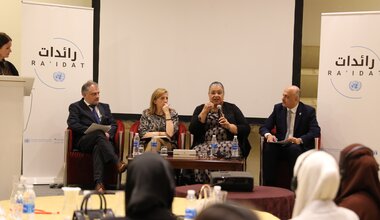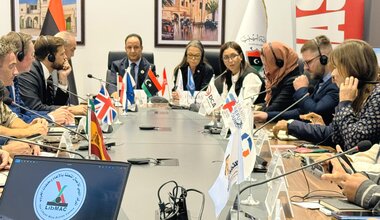Human Rights Report on Civilian Casualties - November 2016
Tunis – From 1 November to 30 November 2016, the United Nations Support Mission in Libya (UNSMIL) documented 89 civilian casualties, including 38 deaths and 51 injuries, during the conduct of hostilities across Libya. Victims included 8 children killed and 16 injured, 27 men killed and 28 injured and 3 women killed and 7 injured.
Civilian Casualties
The majority of civilian deaths were caused by air strikes (12 deaths and 2 injured), while the next leading cause of death was gun shots (11 deaths and 1 injured), followed by shelling (9, 15 injured) and then vehicle-borne improvised explosive devices (6 deaths and 33 injured).
UNSMIL documented 18 deaths and 37 injured in Benghazi, 16 deaths and 13 injured in Sabha, 4 deaths in al-Khoms and 1 injured in Tobruk. The civilian casualty figures for Sabha, related to clashes that started on 17 November, are likely to rise as further information is received.
The civilian casualties figures included four members of a family, a father and his adult daughter and two adult sons, who were killed on 26 November in their house in al-Khoms, Their bodies reportedly showed signs of gunshots and burns. It also included the death of 10 men and 2 children killed from airstrikes in Qanfouda, a neighbourhood of Benghazi where civilians are trapped because of fighting between the Libyan National Army (LNA) and the Benghazi Revolutionaries Shura Council (BRSC).
While no one claimed responsibility for the air strikes, information received indicated that the LNA or their allies carried out the airstrikes that caused civilian casualties in Qanfouda, Benghazi. UNSMIL was unable to determine with certainty which other parties caused civilian casualties in November.
Civilian Facilities
On the evening of 8 November members of an armed group physically attacked medical staff in the Abu Salim hospital. On the same day, unidentified attackers set fire to humanitarian supplies of the Red Crescent in their premises in Sabha.
On 21 November, a car bomb exploded outside of the al-Jalah hospital in Benghazi. The explosion killed 2 men, 2 women and 2 children, and injured 23 others, including 7 children.
Other Casualties
On 5 November, two men from an armed group, formerly named 204 Brigade, that used to be commanded by al-Mahdi al-Barghathi, the designate Minister of Defence, were found dead in al-Marj, Benghazi. They had been abducted from the street on 2 November.
On 15 November, four men were injured when a military funeral was car-bombed in Benghazi.
On 29 November, the bodies of 28 migrants were buried in Beni Walid. The abandoned bodies were found in the area and appeared to have died from malnutrition. Reports received by UNSMIL indicated that several dead bodies of migrants are found every week in the area.
In November, Sheikh al-Omrani, a senior religious figure in the country, was reportedly killed, following his abduction in Tripoli on 6 October.
Note
The figures for civilian casualties set out above only include persons killed or injured in the course of hostilities and who were not directly participating in the hostilities. The figures do not include those casualties that are not a direct result of hostilities, for example executions after capture, torture or abductions, or casualties caused as an indirect consequence of hostilities. The figures are based on information UNSMIL has gathered and cross-checked from a broad range of sources in Libya, including human rights defenders, civil society, current and former officials, employees of local governments, community leaders and members, witnesses, others directly affected and media reports. In order to assess the credibility of information obtained, where possible, UNSMIL reviewed documentary information, including medical records, forensic reports and photographic evidence.
The figures are only those that UNSMIL was able to document in the reporting period. They are not likely to be complete and may change as new information emerges about incidents involving civilian casualties that took place during this period.
Similarly, while UNSMIL has systematically tried to ensure that the cases it documented are based on credible information, further verification would be required to attain a higher standard of proof. Due to the security situation, UNSMIL has not been able to carry out direct site visits in Libya to obtain information. Disruption in communications especially in areas controlled by groups pledging allegiance to ISIL and fear of reprisals against sources further hamper information gathering.
While not all actions leading to civilian casualties breach international humanitarian law, UNSMIL reminds all parties to the conflict that they are under an obligation to target only military objectives. Direct attacks on civilians as well as indiscriminate attacks – which do not distinguish between civilians and fighters – are prohibited. Attacks that are expected to cause incidental loss of civilian life, injury to civilians and damage to civilian objects excessive to the anticipated concrete and direct military advantage are also prohibited. Such attacks amount to war crimes that can be prosecuted by the International Criminal Court.
In order to ensure greater protection of the civilian population and essential infrastructure, all parties engaged in fighting in Libya must cease the use of mortars and other indirect weapons and imprecise aerial bombardments in civilian-populated areas, and not place fighters or other military objectives in populated areas. All executions of captives must cease and all those captured including fighters must be treated humanely in all circumstances. Murdering or torturing captives is also a war crime, regardless of what the captive may be accused of.
 United Nations Peacekeeping
United Nations Peacekeeping UN
UN








